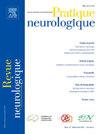Polyradiculoneuropathie inflammatoire démyélinisante chronique : qu’avons-nous appris de la physiopathologie et du traitement ?
Q4 Medicine
引用次数: 0
Abstract
La polyradiculonévrite inflammatoire chronique (PIDC) est un syndrome neurologique caractérisé par une atteinte sensitivomotrice, une aréflexie et des signes de démyélinisation. Les avancées scientifiques ont permis de mieux comprendre ses mécanismes auto-immuns, notamment grâce à la découverte d’auto-anticorps spécifiques et de modèles animaux. Les PIDC présentent une grande hétérogénéité clinique et biologique, suggérant des mécanismes physiopathologiques distincts. Ces découvertes orientent vers des traitements personnalisés, bien que les approches standards (IgIV, corticoïdes) restent centrales. Les nouvelles thérapies ciblant le complément ou les IgG offrent des perspectives pour les cas réfractaires.
Chronic inflammatory demyelinating polyneuropathy (CIDP) is a neurological syndrome characterized by sensorimotor impairment, areflexia, and signs of demyelination. Scientific advancements have provided a better understanding of its autoimmune mechanisms, particularly through the discovery of specific autoantibodies and animal models. CIDP exhibits significant clinical and biological heterogeneity, suggesting distinct pathophysiological mechanisms. These discoveries pave the way for personalized treatments, although standard approaches (IVIg, corticosteroids) remain central. Emerging therapies targeting the complement system or IgG offer promising prospects for refractory cases.
慢性炎症性脱髓鞘性多根神经病:我们从生理病理学和治疗中学到了什么?
慢性炎症性多根神经炎(CPID)是一种神经系统综合征,其特征是感觉运动损伤、反射和脱髓鞘的迹象。科学的进步使人们对其自身免疫机制有了更好的了解,包括特异性自身抗体和动物模型的发现。PIDC具有高度的临床和生物学异质性,表明其生理病理机制不同。这些发现指向了个性化治疗,尽管标准方法(IVIG、皮质激素)仍然是核心。针对补充或IgG的新疗法为抗性病例提供了前景。慢性炎症性脱髓鞘多发性神经病(CIDP)是一种神经系统综合征,其特征是感觉运动障碍、反射和脱髓鞘的迹象。科学的进步使人们对其自身免疫机制有了更好的了解,特别是通过发现特定的自身抗体和动物模型。CIDP表现出显著的临床和生物异质性,表明不同的病理生理机制。这些发现为个性化治疗铺平了道路,尽管标准方法(IVIG,皮质类固醇)仍然是中心。以补充系统或IgG为目标的新兴疗法为屈光不正的病例提供了良好的前景。
本文章由计算机程序翻译,如有差异,请以英文原文为准。
求助全文
约1分钟内获得全文
求助全文

 求助内容:
求助内容: 应助结果提醒方式:
应助结果提醒方式:


